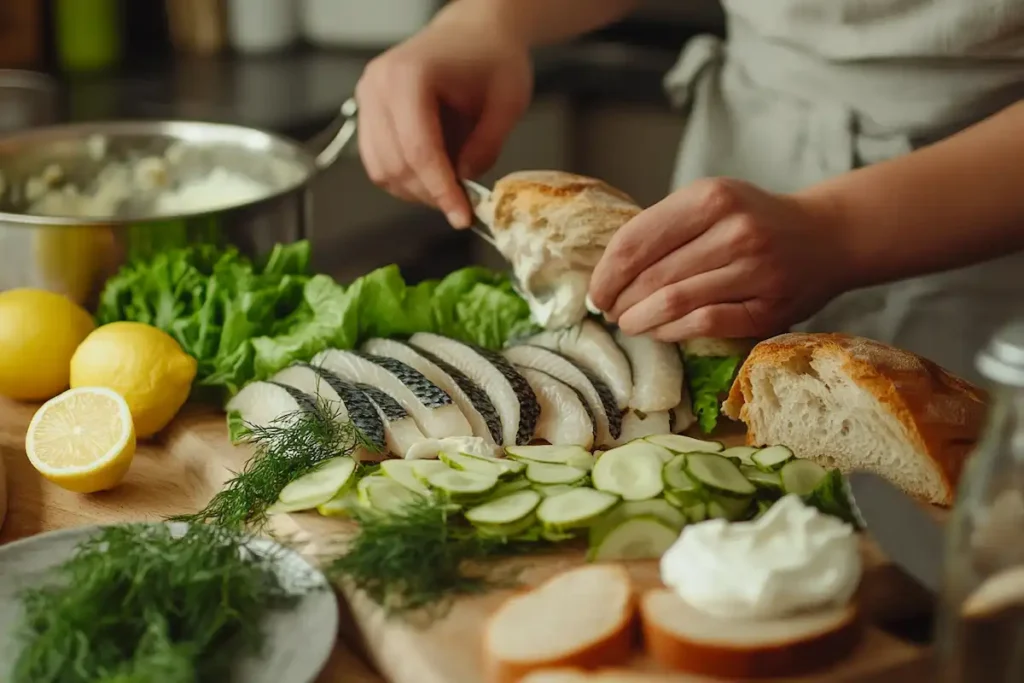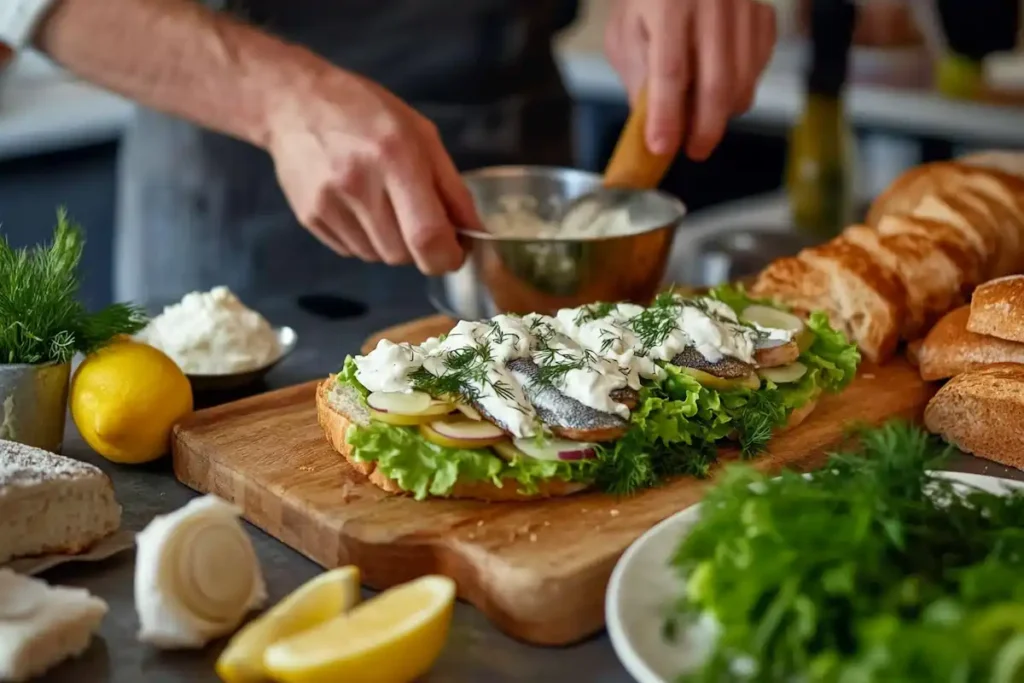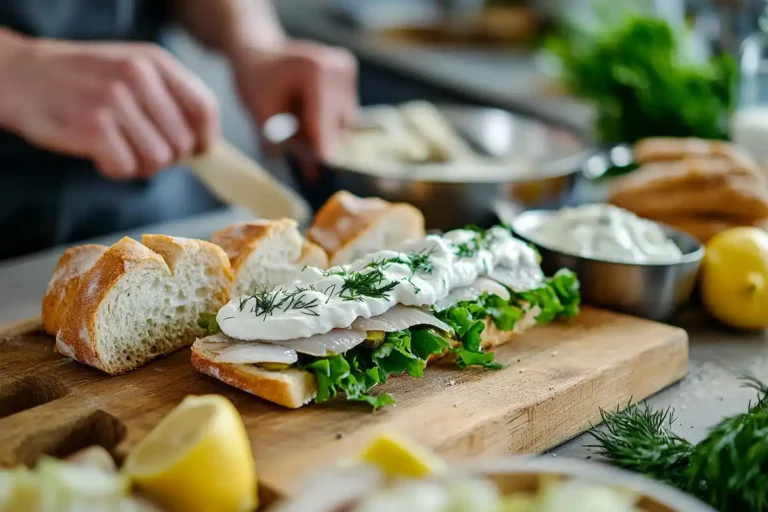1 Introduction to Matjesbrötchen Recipe
1.1 What is Matjesbrötchen Recipe?
Matjesbrötchen Recipe is a traditional German sandwich that chiefly highlights tender pickled herring fillets served in a crusty bread roll. Basically, people in northern Germany, especially in coastal towns, relish this savory treat. Matjes refers to young, lightly salted herring, which is prized for its delicate texture. Although it often includes onions and a tangy sauce, you can still customize it with additional ingredients. Indeed, the soft fish pairs perfectly with a crispy roll, thereby creating a delightful contrast. Concurrently, the subtle saltiness of the herring complements the refreshing crunch of other toppings. Furthermore, locals occasionally claim that this sandwich offers a taste of the sea with every single bite. Correspondingly, its popularity has spread beyond coastal areas, but it remains a quintessential option in harborside eateries. For more information on Germany’s northern coastal cuisines, check out the German National Tourist Board’s official site.
1.2 Historical Background
The humble beginnings of Matjesbrötchen Recipe trace back to maritime communities by the North and Baltic Seas. Formerly, fishermen needed preserved fish on extended voyages, so they relied on pickled herring to sustain them at sea. Eventually, locals recognized its unique flavor, and they started serving it in bread rolls for convenience. Comparatively, the rise of coastal markets and bustling harbors transformed matjes into an iconic street food. Matjesbrötchen soon developed into a cherished staple, especially among sailors who craved quick yet hearty meals during demanding work hours. Concurrently, the sandwich evolved from a pragmatic meal into a cultural treasure. Today, Matjesbrötchen openly symbolizes Germany’s seafaring legacy, representing the connection between fishing traditions and everyday dining. Although tastes have changed over time, the widespread love for this sandwich persists. Correspondingly, it stands as a testament to the region’s enduring culinary pride, which continues to enchant visitors.
1.3 Cultural Significance
Nowadays, Matjesbrötchen Recipe is more than just a sandwich—rather, it’s a cultural institution that emphasizes German street food heritage. Indeed, you will find it everywhere, including festivals, local fairs, and family reunions. Furthermore, its authentic flavors and simple preparation appeal to a broad range of palates, giving it both local and international admirers. Correspondingly, this beloved treat underscores how culinary customs can bring people together. Moreover, Matjesbrötchen represents the heart of northern German life, highlighting the connection between coastal communities and their reliance on the sea. Altogether, when you bite into this sandwich, you partake in a timeless tradition that blends history, community, and flavor in every mouthful.

2. Ingredients and Preparation
2.1 Selecting the Right Matjes Herring
Choosing top-notch matjes herring is undeniably vital if you want an authentic Matjesbrötchen. Firstly, make sure the fillets are firm and shiny, and double-check they have a fresh aroma. Matjes fillets come from younger herring, which are brined using mild seasoning. This process ensures a tender texture that is ideal for sandwiches. Additionally, look for fillets that aren’t overly salty, because balance is paramount. Correspondingly, choose reputable sources—e.g., your local fishmonger or trusted grocery store—for consistently high-quality herring. Altogether, these steps guarantee the best flavor while preserving the fish’s delicate essence.
2.2 Bread Selection
Brötchen literally means bread roll in German, and it sets the stage for your sandwich’s overall quality. Comparatively, a crusty, fresh roll provides an excellent contrast to the softness of the matjes herring. However, you could also opt for rustic buns or similarly firm rolls. Nevertheless, Kaiser rolls remain popular, albeit other crusty varieties work just as well. Additionally, ensure the bread is neither stale nor too dense. Correspondingly, that way, your Matjesbrötchen will maintain a pleasant bite without becoming soggy.
2.3 Additional Toppings
Thinly sliced red onions, crisp lettuce, and pickled cucumbers are equally standard toppings in a Matjesbrötchen. They add layers of flavor and texture by offering acidity, crunch, and freshness. Besides, some people like to include a sprinkling of chopped herbs for added zest. Similarly, diced bell peppers or radishes may be tossed in, albeit sparingly, if you crave more color or a sharper bite. Doubtedly, you can even go simpler with just onion and herring if you prefer minimalism. Nevertheless, most folks find that these classic extras significantly enhance the sandwich, thus creating a balanced flavor profile.
2.4 Homemade Sauce Preparation
In many households, a creamy sauce featuring sour cream, mayonnaise, and mustard is a must-try companion for Matjesbrötchen Recipe. Explicitly, you may blend 2 tablespoons of sour cream, 1 tablespoon of mayonnaise, and 1 teaspoon of mustard. Then, add fresh dill for a bright herbal note. However, you can adjust the sauce consistency by adding more or less of each ingredient. Certainly, some people include a tiny dash of pepper or a few drops of lemon juice for an extra zing. Altogether, this sauce underscores the salty tang of the herring, making the entire sandwich more scrumptious.
3. Step-by-Step Recipe
3.1 Preparing the Ingredients
Before assembling, drain the matjes herring fillets and pat them dry with a paper towel. Meanwhile, gather your fresh bread rolls. Ingredients List:
- 2–3 matjes herring fillets
- 2 crusty bread rolls
- 1 small red onion, thinly sliced
- 2 pickled cucumbers, sliced
- 2 lettuce leaves, rinsed and dried
- 2 tablespoons sour cream
- 1 tablespoon mayonnaise
- 1 teaspoon mustard
- 1 teaspoon chopped fresh dill
- A pinch of black pepper (optional)
Initially, slice the onions and pickles as thinly as possible. Afterwards, wash and pat dry the lettuce leaves. Concurrently, mix the sour cream, mayonnaise, mustard, and dill in a bowl, and season with pepper, if desired. Finally, get all components organized before you begin.
3.2 Assembling the Sandwich
- Slice the rolls: Cut each bread roll horizontally, ensuring a smooth top and bottom half.
- Spread the sauce: Generously slather the creamy dressing on both halves.
- Layer the lettuce: Place a lettuce leaf on the bottom half of the roll.
- Add the herring: Carefully lay down a matjes fillet on top of the lettuce.
- Top it off: Scatter onion slices and pickled cucumber on top of the herring.
- Close the sandwich: Press the top half of the roll gently to secure the fillings.
Surely, you can adjust the amounts of onions and pickles depending on personal taste. Also, if you love extra sauce, you can spread an additional layer. However, it’s advisable to assemble right before serving, lest the roll becomes soggy.
3.3 Serving Suggestions
Serve your finished Matjesbrötchen straightaway. Consequently, the sandwich remains fresh and crisp. Moreover, you might pair it with a simple green salad, freshly cut veggies, or your favorite side dish, thereby complementing the savory flavors. Additionally, a dash of lemon juice over the herring can deliver an extra layer of brightness. Overall, Matjesbrötchen shines as a crowd-pleaser for picnics, lunch breaks, or outdoor gatherings.

4. Variations and Tips
4.1 Regional Variations
Different German regions, correspondingly, offer their own spin on Matjesbrötchen. Occasionally, some folks add diced apples to balance the fish’s salty nature with sweetness. Conversely, others stir in a bit of horseradish for a spicy jolt. Moreover, variations might include extra herbs or unusual condiments. Yet, the essence of this sandwich remains the same: fresh matjes herring, quality bread, and an array of tangy toppings. Hence, exploring these variations opens up a whole new world of tastes, especially if you’re a devoted seafood enthusiast. For additional inspiration, you can explore the German Foods website to learn about regional spins on classic dishes.
4.2 Tips for the Perfect Matjesbrötchen Recipe
When striving for the perfect Matjesbrötchen, ensure all the ingredients—namely the bread, herring, and vegetables—are exceptionally fresh. Concurrently, assemble the sandwich no earlier than a few minutes before eating. Otherwise, the bread might soften too much, undermining that lovely textural contrast. Equally important, adjust your sauce recipe based on personal preference, adding herbs, lemon juice, or a pinch of spice. Additionally, keep the herring fillets chilled until you’re ready to build your sandwich to preserve their flavor. Ultimately, experimentation is key, albeit respecting the core elements that define this iconic treat.
4.3 Nutritional Information
Nutritional Content (Per 100g)
The Matjesbrötchen Recipe is not only delicious but also provides a balanced nutritional profile, primarily due to the healthy fats from the herring and the fiber from fresh vegetables. Below is the approximate nutritional breakdown:
| Nutrient | Amount (Per 100g) |
|---|---|
| Calories | 210 kcal |
| Protein | 11 g |
| Fat | 9 g |
| Saturated Fat | 2 g |
| Carbohydrates | 22 g |
| Fiber | 1 g |
| Sugar | 3 g |
| Sodium | 450 mg |
| Omega-3 Fatty Acids | 1.2 g |
Key Nutritional Highlights
- Rich in Omega-3 Fatty Acids: The herring provides essential omega-3 fats, which are crucial for heart and brain health.
- High-Quality Protein: Matjes herring is an excellent source of protein, making it an ideal choice for maintaining muscle and tissue health.
- Moderate Carbohydrates: The bread roll contributes carbohydrates, which provide quick energy.
- Low Sugar Content: This sandwich is naturally low in sugar, making it a wholesome meal or snack.
Note: Nutritional values may vary slightly based on portion size, ingredients, and preparation methods.
5. Frequently Asked Questions about Matjesbrötchen Recipe
5.1 What is the recipe for Mangria?
Mangria is a fruity beverage that people often enjoy on warm days. Although there are numerous versions, a non-alcoholic take includes blending fruit juices and sparkling water for a refreshing twist. Basically, you can mix equal parts orange juice and grape juice, then add a bit of sparkling water. Next, throw in chopped fruits—like apples and oranges—and let it chill. Conversely, you could incorporate a few sprigs of mint for extra zest. Afterwards, serve it over ice. Indeed, this tasty mocktail is a simple way to enjoy a colorful drink without strong ingredients.
5.2 What is the thunderbrew recipe?
Thunderbrew stems from a fictional universe, yet fans have crafted non-alcoholic versions for real-world fun. Initially, mix ginger ale with a bit of lemon-lime soda for a fizzy base. Also, add a dash of apple cider for a bold tang. Then, stir in some honey to sweeten the blend, albeit taste it as you go to avoid over-sweetening. Markedly, you can garnish your Thunderbrew with a cinnamon stick or lemon slice for extra flair. Correspondingly, this imaginative drink brings a spark of fantasy to any gathering.
5.3 What is the recipe for the Coaltana?
The Coaltana is recognized as a quick-to-make, refreshing concoction that, in its non-alcoholic version, incorporates cola and a splash of citrus. Equally, you might add a bit of lime juice to brighten it. Then, pour over ice for a cool and invigorating treat. However, you can swap the cola for a decaffeinated version, if preferred. Forthwith, garnish your Coaltana with a lime wedge or fresh fruit slices. This straightforward recipe proves that easy drinks can be fun and thirst-quenching, especially on a hot day.
6. Conclusion
6.1 Embracing German Culinary Traditions
The Matjesbrötchen is much more than a simple sandwich—it is a culinary emblem that represents the intersection of German culture, history, and coastal life. Rooted in the traditions of northern Germany, particularly along the North Sea and Baltic coasts, this dish embodies the resourcefulness of fishing communities. Back when refrigeration was nonexistent, preserving fish by pickling was an essential skill. Matjes herring, with its young and tender flesh, became a cornerstone of coastal diets due to its rich flavor and long shelf life.
Beyond its historical roots, Matjesbrötchen serves as a window into the communal spirit of German culinary traditions. Harbor towns and seaside markets bustled with vendors selling this sandwich to both locals and travelers, turning it into a street food favorite. Today, its widespread appeal is evident in its appearance at cultural events, seasonal fairs, and even modern restaurants that pay homage to regional delicacies.
Preparing Matjesbrötchen at home allows you to connect with these traditions while celebrating the flavors of fresh seafood and simple, wholesome ingredients. In doing so, you not only enjoy a delicious meal but also partake in a ritual that has been passed down through generations, blending practicality with the joy of savoring good food.
6.2 Encouragement to Experiment
While the classic Matjesbrötchen recipe holds timeless charm, its versatility invites endless possibilities for customization. The foundational elements—matjes herring and a crusty roll—are perfect canvases for innovation. For instance, adding thinly sliced apple brings a hint of sweetness that balances the salty and tangy flavors. Conversely, incorporating spicy chili flakes or hot mustard can add a bold kick for those who enjoy heat.
Exploring global culinary influences can also yield unique twists. A dollop of tzatziki or a sprinkling of za’atar could infuse Mediterranean flavors, while using kimchi or pickled radishes might give the sandwich an Asian-inspired flair. Additionally, experimenting with artisanal bread, such as sourdough or seeded rolls, can elevate the texture and taste.
Don’t hesitate to create your own signature version of this classic. Try substituting the creamy sauce with vegan alternatives, like tahini or avocado mash, for a plant-based twist. Even slight variations, such as swapping lettuce for arugula or mixing fresh herbs into the sauce, can offer delightful surprises.
Above all, the beauty of Matjesbrötchen lies in its adaptability. By preserving its essence while experimenting with ingredients, you not only honor its heritage but also make it your own, ensuring this beloved dish continues to evolve and delight palates across generations.

